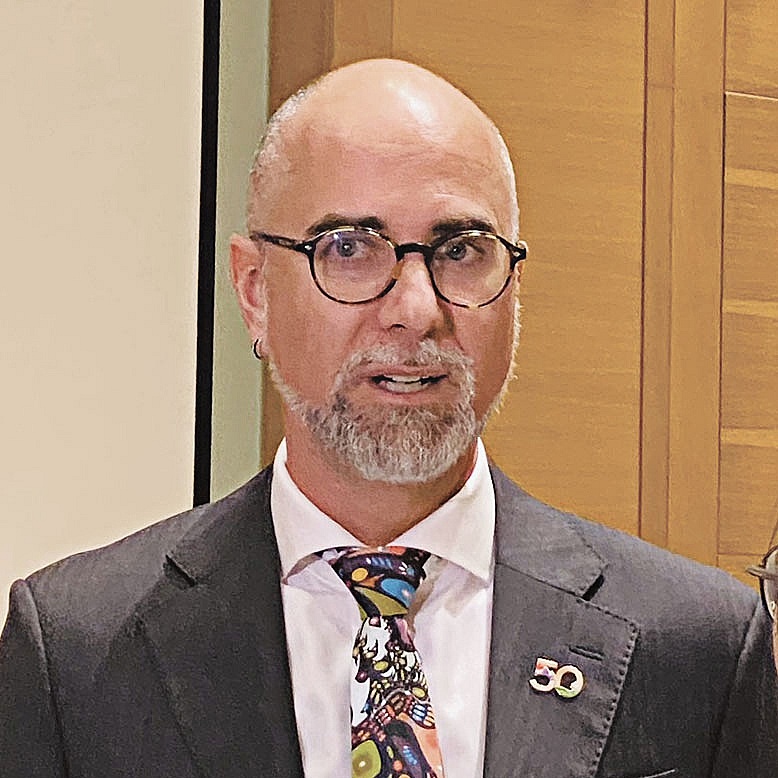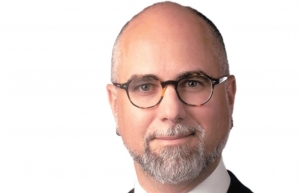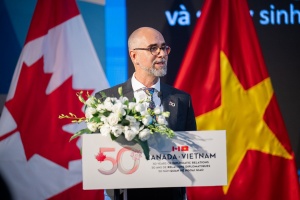Canada elevates technical assistance
Canada ranks 14th out of the countries and territories investing in Vietnam, with nearly $5 billion pumped in. How would you assess the attractiveness of Vietnam’s investment environment moving forward?
 |
| Shawn Steil, Canadian Ambassador to Vietnam |
The thing to remember about Canadian investors compared to some others is they’re quite conservative. For example, two of our biggest investors in Vietnam are insurance and financial companies. And through all of this turmoil in banking markets, insurance markets, and stock exchanges, Canada has fared better than most countries because we have a strong fiscal responsibility and a disciplined approach to financing.
There’s a good and bad side to that, but Canadian investors tend to be quite conservative. That means when they look for opportunities in Vietnam, they will consider what the risks are, and how they are going to manage the balance between potential benefits and the risks. For them, in particular, the regulatory environment, stability, transparency, and reliability is critical.
Canada has some of the world’s largest investment funds. They are looking at law, infrastructure, and they need to know that those investments will be stable, that the risk is being shared between governments and the private sector. So we are working with Vietnam, for example, on public-private partnerships and infrastructure to kind of hone the regulatory environment to ensure that balance of risk is attractive to investors.
Vietnam wants to transition to renewable energy and greener funding. How does Canada plan to provide support and collaborate with Vietnam in this area?
Being an economy that is growing fast, Vietnam’s people have to be conscious about the environment and about ensuring those economic benefits get to everyone.
On climate change and clean energy, Vietnam is one of the countries most vulnerable in the world to climate change. Canada has shifted even some of our development assistance from basic human needs to supporting the clean energy transition. Canada is a proud partner of the Just Energy Transition Partnership in Vietnam and is contributing resources technical expertise and know how to support Vietnam’s transition to more clean energy.
Through that partnership, we’re elevating our assistance to support Vietnam in not only increasing renewable energy production, but also looking at increasing the capacity to store energy, which is important for renewables and to improve transmission. Because once using renewables, you need a smart grid to take large volumes of electricity at certain times.
One way we are already working is through our development assistance. We are already providing technical assistance for helping to manage smart coastal communities; for example, how to sustain forests in Highland areas to support economic benefits, while preserving the forests. This is a key issue everywhere in the world. So we have already started to move in these ways and support Vietnam’s clean transition and environmental protection.
In addition, Canada was a founding member of the Global Plastics Action Partnership. As an ambassador, I sit on the leadership board for Vietnam’s plastics plan. We are providing support technical expertise for a long-term plan in Vietnam on how to reduce plastics.
Plastics end up in the oceans, they all do. Vietnam depends on its oceans for fisheries, for offshore wind energy, and for tourism, and so reducing plastic in the environment is key. And Canada is a vital partner for Vietnam in supporting solutions, technological aspects, and policy to help reduce plastics.
Finally, we are particularly excited about supporting carbon pricing in Vietnam, and the Vietnamese government has a plan to pilot carbon pricing by 2025 and have a national carbon market by 2028. Canada is one of Vietnam’s closest partners in supporting options to pursue this goal.
How have exports from Vietnam to Canada been boosted through trade deals?
Since the Comprehensive and Progressive Agreement for Trans-Pacific Partnership came into force here in Vietnam in 2018, exports to Canada have grown really rapidly. In fact, out of our total bilateral trade, about 93 per cent is Vietnamese exports to Canada. Vietnamese products, seafood, fruits, furniture, shoes, clothing, and electronics are finding an enormous market in Canada.
Although all economies are having a little bit of difficulty right now, Canadians are still spending. We are continuing to purchase really high-quality Vietnamese products and people are excited to have the opportunity to eat Vietnamese shrimp, cashew nuts, and to wear Vietnamese-made clothes.
So we expect that trade, given low tariff rates per preferred treatment, is going to increase, and Vietnamese products will continue to find an excellent market in Canada.
 | The solutions for stronger Canadian moves in Vietnam Vietnam and Canada are going through a heyday in bilateral ties, and currently celebrating a 5-year comprehensive partnership. Canadian Ambassador to Vietnam Shawn Perry Steil talked to VIR’s Thanh Tung about how the cooperation will continue to flourish. |
 | Canada and Vietnam commemorate 50th year of diplomatic relations The relationship between Canada and Vietnam has developed in a gratifying way and has achieved many great breakthroughs over the past five decades, according to the Canadian Ambassador to Vietnam, Shawn Perry Steil. |
What the stars mean:
★ Poor ★ ★ Promising ★★★ Good ★★★★ Very good ★★★★★ Exceptional
Related Contents
Latest News
More News
- Global partnerships key to Vietnam’s IFC development (December 26, 2025 | 16:18)
- Vingroup pulls out of bid to invest in North-South high-speed railway (December 26, 2025 | 11:42)
- Strengthening supply chains through trade promotions and customs reform (December 24, 2025 | 14:00)
- PM orders investment model for North–South high-speed rail (December 22, 2025 | 17:43)
- LS Eco Energy to invest in Vietnam rare earth sector (December 22, 2025 | 17:31)
- Government moves to establish International Financial Centre (December 21, 2025 | 21:00)
- Vietnam's IFC to target global investment flows (December 21, 2025 | 18:00)
- Two national hospitals expand capacity with new facilities (December 20, 2025 | 09:00)
- Ha Tinh breaks ground on major Vingroup industrial and energy projects (December 19, 2025 | 18:24)
- EVN launches major power infrastructure projects nationwide (December 19, 2025 | 18:17)

 Tag:
Tag:





















 Mobile Version
Mobile Version